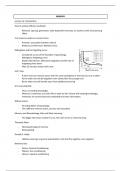MEMORY
Lecture 1a: Introduction
How to achieve efficient studying?
- Retrieval, spacing, generation, state-dependent learning: no alcohol, levels of processing
effect
First memory studies in ancient times
- Aristotle: association between stimuli
- Rhetorica ad Herenium: Method of loci
Ebbinghaus and his forgetting curve:
- Considered as one of the founders of psychology.
- Ebbinghaus forgetting curve:
- Rapid initial decline, afterwards stagnates and the rate of
forgetting slows down.
- After 20 minutes almost half is lost
Jost’s Law
- If there are two memory traces with the same probability of retrieval, but one is older:
- A) the older one will be forgotten more slowly than the younger one
- B) the older one will benefit more from additional learning
Sir Francis Bartlett:
- Focus on existing knowledge.
- Memory is schemata, our brain fills in what we don’t know with existing knowledge;
memories are constructed and completed by known information.
William James:
- Founding father of psychology
- Two different memory stores, primary and secondary
Memory and Neurobiology: Rats and Maze Learning:
- The bigger the lesion created in a rat, the more errors in maze learning.
Theodule Ribot:
- Neuropsychology of memory
- Ribot grading
Donald O. Hebb:
- Hebbian learning, long-term potentiation: cells that fire together, wire together
Behaviourists:
- Pavlov: Classical Conditioning
- Watson: fear conditioning
- Skinner: operant conditioning
,What was cognitive Psychology influenced by from 1950?
- Emerging computer science in the 1940s
- Shannon and weaver’s ‘A mathematical theory of communication’ – ‘bit’ theory
- Computer memory: Ram vs. Hard-disk = STM vs LTM
- Memory is now viewed as a carrier of information that is manipulated during cognition
What were the theories and emerging ideas that influenced cognitive psychology after 1950?
- Miller’s law: the magical number 7+/-
- Broadbent’s information model: bottleneck, filter, limited capacity channel
Atkinson and Shiffrin Model:
- Multi-store model
- Comprised of sensory memory; short term
memory; long term memory
- The model posits that for information to
move from one store to another encoding,
storage, and retrieval are necessary.
- The model also emphasizes the
importance of rehearsal to transfer information from the STM to LTM
Baddley and Hitch Model:
- Working memory components:
1. Central Executive: control centre
2. Phonological Loop: deals with auditory information and language
3. Visuospatial Sketchpad: deals with visual and spatial information
4. Episodic Buffer: (added later) integrates information from the phonological loop,
visuospatial sketchpad, and long-term memory into a coherent sequence
- This model is better than previous STM as it emphasizes the dynamic and flexible nature of
WM
Tulving:
- Posits different memory stores:
- Episodic: temporal events in subjective time
- Semantic: general knowledge (no event structure)
- Procedural: operations involved in executing task (knowing how to), stimuli and response
memory
,Lecture 1b: Neuropsychology
What is a popular misconception about memory?
- That memory traces are stored at specific locations in the brain.
- Penfields neural stimulation contributed to this notion because, during his epilepsy studies,
he discovered that electrical stimulation of certain areas of the brain would lead to altered
memories.
Hebbian Learning:
- LTP: what fires together, wires together; so more frequently strengthened connections are
stronger.
Spines and neural connections:
- Grow and shrink over time, seemingly randomly.
- Neural connections fluctuate like crazy.
- Spine fluctuations % per day:
o Relative change: about 5% to 10% per day
o Absolute change: might be smaller, indicating only slight increases or decreases.
How does this relate to LTM consolidation?
- This might be an active mechanism of long-term consolidation.
- Allowing for new memories to be formed and old ones to be forgotten, a dynamic process
that contributes to memory consolidation.
Hippocampus:
- Essential for episodic memory
- And is specialized in spatial memory, Morris water maze -> using place and grid cells the
mouse knows where to go
How does a lesion to the hippocampus impact mice in the Morris water maze:
- They have a much harder time finding the
platform again.
- Especially when the starting position
varies, they are almost unable to find it.
- When the starting position stays the
same, they find it after some time.
Updated views on hippocampus and memory:
- It was first thought that the hippocampus specialized in spatial memory, however, it seems to
be that the hippocampus rather plays a role in remembering complex associations
Para hippocampal areas:
- Essential for the formation of complex associations, e.g. between
objects and their context
- Also, for encoding, recognition, and recall
- Involved in episodic memory.
, Perirhinal cortex:
- Concerned with recognition: the feeling of familiarity.
Declarative (explicit) memory (all stores: facts, events):
- All mediated by medial temporal lobe, neocortex
Model of the hippocampus-cortex dialog during memory consolidation:
- Link System (hippocampus): initially encodes and binds different aspects of memory into a
coherent whole, and links it together.
- Trace System (Neocortex): storing memory traces into long-term memory.
- Modulatory System (Basal Forebrain): influencing the consolidation process through
neuromodulators.
Stages of storage and consolidation:
- Links and traces become more complex and more stable with every stage.
Memory stores: Why is this distinction necessary?
Episodic Memory Remembering
Semantic Memory Knowing
➔ Different pathologies:
o Semantic Dementia vs. Alzheimer’s dementia patients (episodic)
o These diseases involve different parts of the brain.
Brain regions and memory overview
Explicit memory: retrieve something from memory.
Implicit memory: (possibly) unconscious effect of behaviour due to previous experience
- E.g.: activation of the amygdala enhances memory, watching a horror movie will be
remembered more easily than watching a boring lecture
Why is the distinction between explicit and implicit memory necessary?
- Anterograde amnesia patients have implicit memory but lack explicit memory.
- Different parts of the brain are involved.




